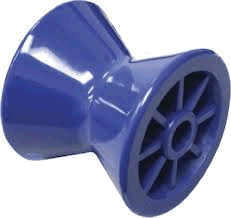Choosing the right polyurethane product for your application can be an overwhelming process. With so many different types of applications, practically no two applications are the same. The trick is to figure out what material properties are the most important, while at the same time keeping price and processability in mind.
Polyurethane (PU) elastomers are most often used because of their overall toughness, especially when it comes to abrasion resistance. Other advantages include high cut-and-tear resistance, good dynamic performance under load (low hysteresis), and ease of processing. PU is also very versatile in what type of material form it can take. Various formulations can achieve very low durometer (hardness), similar to a soft rubber or silicone material, while others can be cast as very hard material like nylon. At Anderson Development, we optimize PU properties such as compression set, resilience, abrasion resistance, flex fatigue, load bearing capability, solvent resistance, hydrolysis resistance, thermal stability, and UV stability to name a few.
Below is a table with general property info for a given type of polyurethane system.
| Polyurethane Description | General Attributes |
| Aromatic Isocyanate/Polyester Backbone | Excellent physical properties, excellent abrasion resistance, good solvent resistance |
| Aromatic Isocyanate/PTMEG Polyether Backbone | High resilience, excellent dynamic performance, great physical properties, good abrasion resistance, great hydrolytic stability, excellent low temperature flexibility |
| Aromatic Isocyanate/PPG Polyether Backbone | Good physical properties, low viscosity (easier to process), great hydrolytic stability |
| Aliphatic Isocyanate/Polyether Backbone | Great physical properties, excellent thermal stability, excellent light stability |
| Specialty Isocyanate/Polyether or Polyester | Ultimate toughness with excellent physicals for very demanding applications |
Below are a few example applications in which cast PU has excelled and an explanation of why the properties of a particular PU system make it the right choice.
V-rollers
V-rollers need load bearing capabilities and low hysteresis in order to succeed and PTMEG-based cast polyurethane offers both of these properties. In addition, cast polyurethane can be formulated for low compression set. When a load is placed on a stationary roller for a period of time it will resist forming a flat spot, so that when it starts to rotate again, the motion will be smooth. In high speed applications, the low hysteresis (low heat buildup) of the polyurethane allows it to run faster without getting so hot that it deforms from internal melting. The high resilience, or rebound and low tan delta, which is a measure of energy absorption, shows that a PTMEG-based material will perform well dynamically.
Seals/Gaskets
Cast polyurethane makes a good material for seals because of its versatility. Seals can be soft (40-50 Shore A) or a little bit more rigid (95 Shore A or higher), depending on the stress that is put on the seal or gasket. It is critical to have a good compression set so that the seal won’t take a set when the stress is relieved and will keep a tight seal. Good flex fatigue and hysteresis may also be an important property if the seal or gasket is being flexed or compressed cyclically. Also, depending on what type of fluid (gas or liquid) the seal is containing and the temperature of the application, a specific type of urethane might need to be used.
For applications that need a soft, tough urethane, a polyester urethane is typically used, especially in situations with exposure to oil or solvents, as is often the case with seals and gaskets. A polyester polyurethane has excellent flex fatigue, too. In the case where the fluid is air or a water-based material, a polyether polyurethane should be used.
Bumpers
The key for a good bumper pad is resilience and toughness. The bumper is ultimately a buffer between two surfaces or objects. A high resilience, or rebound material, results in a bouncy material so that when the pad is bumped, the energy is deflected. On the other end of the spectrum is a low rebound material in which the energy is absorbed, similar to a dead blow hammer. Cast polyurethane can have high or low rebound.
Scraper blades
Scraper blades, which are used in many different industries for cleaning and scraping a belt or other objects, see a lot of abrasion and wear and that why cast PU is used. With its great abrasion resistance, cast PU outperforms other materials such as steel and rubber – and less down-time means higher productivity.
While there is usually a polyurethane type that will work for every application, the material does have its limits. In temperatures above 150°C, hot environments with humidity, or exposure to glycols or amines, materials other than polyurethane should be considered.
Connect with Us
For more information about Anderson Development’s products, please contact us at [email protected].



